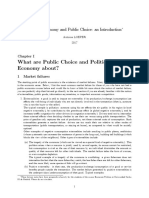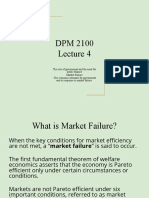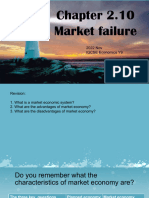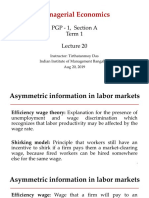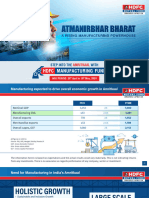Applied Economics
Applied Economics
Uploaded by
Janah MirandaCopyright:
Available Formats
Applied Economics
Applied Economics
Uploaded by
Janah MirandaOriginal Title
Copyright
Available Formats
Share this document
Did you find this document useful?
Is this content inappropriate?
Copyright:
Available Formats
Applied Economics
Applied Economics
Uploaded by
Janah MirandaCopyright:
Available Formats
FINAL EXAMINATION
APPLIED ECONOMICS
Final Examination
First Semester, School Year 2022-2023
Ma’am Janah C. Miranda
NAME: Date:
Course and Section:
I. Identification: Wrong spelling is wrong. 2pts each
1. Is the economic situation defined by an inefficient distribution of goods and
services in the free market.
2. Is an effect on a third party which is caused by the production or consumption
of a good or service.
3. Means producing at the lowest cost possible without any waste.
4. Means that among the points on the production possibility frontier, the point
that is chosen is socially preferred.
5. Enacting specific laws.
6. Government controls the supply of goods that have positive externalities.
7. Placing taxes on certain goods to discourage use and internalize external costs.
8. Encourages or discourages consumption.
9. Permits that allow firms to produce a certain amount of something, commonly
pollution.
10. Reducing the price of a good based on the public benefit that is gained.
II. TRUE or FALSE. (2pts each)
1. The theoretical efficiency of perfect competition does provide a useful benchmark for
comparing the issues that arise from these real-world problems.
2. For market structures such as monopoly, monopolistic competition, and oligopoly, which
are more frequently observed in the real world than perfect competition, firms will not
always produce at the minimum of average cost, nor will they always set price equal to
marginal cost. Your health is also valuable, and the costs of repairing it in the case of
accident or illness are significant enough that it also requires insurance coverage.
3. In Western cultures, prices for consumer goods are usually not negotiable; consumers
expect to pay the price on the price tag.
4. Price advantage can sometimes come through timing.
5. Some products are naturally dated, such as calendars or tax preparation software, and so
may be discounted as they near their expiration date.
6. If you are not satisfied due to a product defect, you can contact the retailer or
manufacturer.
7. In a transaction, the producer and consumer are the first and second parties, and third
parties include any individual, organization, property owner, or a resource that is
indirectly affected
8. The externalities by nature are generally environmental such as natural resources or
public health.
9. Due to the structure of markets, it is impossible for them to be perfect.
10. For one thing, consumers’ ability to pay reflects the income distribution in a particular
society.
III. Choose the letter of the correct answer: 2PTS EACH
Causes of Market Failure:
A. Abuse of Monopoly Power D. Overprovision of Demerit
B. Environmental Concerns Goods
C. Lack of Public Goods E. The Underproduction of
Merit Goods
1. A merit good is a private good that society believes is under-consumed, often with
positive externalities. For example education, healthcare, and sports centers.
2. Imperfect markets restrict output in an attempt to maximize profit.
3. Effects on the environment as important considerations as well as sustainable
development.
4. The public goods are commodities or services that benefit all members of society,
and which are often provided for free through public taxation.
5. A demerit good is a private good that society believes is over consumed, often
with negative externalities. For example cigarettes, alcohol, and prostitution.
IV. Differentiate the following:
Positive externality:5pts
Negative externality:5pts
Explain the following:
Free-rider problem:5pts
Perfect Competition: Give Characteristics of perfect competition:10pts
You might also like
- Apparel Packing Method Manual of Target AustraliaDocument21 pagesApparel Packing Method Manual of Target AustraliaGarmentLearner100% (2)
- Essentials of Economics 7th Edition Gregory Mankiw Solutions ManualDocument15 pagesEssentials of Economics 7th Edition Gregory Mankiw Solutions Manualsexton.garookuh6lsjr100% (29)
- Lectures Notes PE CIII Spanish 2022 Capitulos 1-2Document30 pagesLectures Notes PE CIII Spanish 2022 Capitulos 1-2vegaNo ratings yet
- L8 Economic Issues and Market FailuresDocument25 pagesL8 Economic Issues and Market Failureskurumitokisaki967No ratings yet
- III. Government Intervention in The Price SystemDocument7 pagesIII. Government Intervention in The Price SystemJosephBurleson93No ratings yet
- Lesson 02 - Market Failure, Public Goods & ExternalitiesDocument19 pagesLesson 02 - Market Failure, Public Goods & ExternalitiesMetoo ChyNo ratings yet
- Market FailureDocument26 pagesMarket Failurepratishdassani12No ratings yet
- Economics Unit 5 - 1457145468349Document5 pagesEconomics Unit 5 - 1457145468349VaanazhaganNo ratings yet
- Government Markets: Chapter in A NutshellDocument11 pagesGovernment Markets: Chapter in A NutshellNatasha JohnNo ratings yet
- Market FailuresDocument36 pagesMarket Failuresyansisay00No ratings yet
- Chapter 1 - Summary and Multiple Choice QuestionsDocument3 pagesChapter 1 - Summary and Multiple Choice QuestionsHoàng HàNo ratings yet
- Lectures Notes PE CIII 2020 April 1 AGDocument72 pagesLectures Notes PE CIII 2020 April 1 AGBryan BustamanteNo ratings yet
- Gas 12 Applied Econ Module 1Document20 pagesGas 12 Applied Econ Module 1Edrin Roy Cachero Sy100% (1)
- Microeconomics - Ridiche Ioan AntonioDocument11 pagesMicroeconomics - Ridiche Ioan AntonioAntonio RidicheNo ratings yet
- Micro Chapter 5 Study Guide Questions 14eDocument4 pagesMicro Chapter 5 Study Guide Questions 14eBeauponte Pouky MezonlinNo ratings yet
- DPM 2100 Lecture 4Document27 pagesDPM 2100 Lecture 4Shawaz HusainNo ratings yet
- IGCSE Economics Self Assessment Chapter 14 AnswersDocument2 pagesIGCSE Economics Self Assessment Chapter 14 AnswersDesre100% (1)
- Social Implications of EconomicsDocument2 pagesSocial Implications of EconomicsLizzy ErasmusNo ratings yet
- Desy Wahyu Rahmawati Imabs A (20180410104) : Economics AssignmentDocument5 pagesDesy Wahyu Rahmawati Imabs A (20180410104) : Economics AssignmentDesy Wahyu RahmawatiNo ratings yet
- Allocative Efficiency, Market Failure and Government Measures To Address Market FailureDocument16 pagesAllocative Efficiency, Market Failure and Government Measures To Address Market Failurekim2hockinsNo ratings yet
- Market FailureDocument8 pagesMarket FailuresassinemichelNo ratings yet
- IGCSE Market FailureDocument27 pagesIGCSE Market Failurerwanjala.khalsaNo ratings yet
- Unit 2 Part 1Document18 pagesUnit 2 Part 1FeelipeferrerNo ratings yet
- Introduction To Market FailureDocument3 pagesIntroduction To Market FailureJennifer Baquial Comia100% (1)
- Economics StuffDocument5 pagesEconomics StuffVigneshNo ratings yet
- 2.10 Market FailureDocument102 pages2.10 Market FailureHiken YiuNo ratings yet
- Econ HWDocument3 pagesEcon HWCourtneyNo ratings yet
- Public Goods, Externalities, and Information Asymmetries: Lecture NotesDocument4 pagesPublic Goods, Externalities, and Information Asymmetries: Lecture NotesalyannahhidagoNo ratings yet
- Externalities: Answers To The Review QuizzesDocument13 pagesExternalities: Answers To The Review QuizzesWeko CheangNo ratings yet
- Be Notes: Ques 5: Advantage and Disadvantage of PrivatisationDocument7 pagesBe Notes: Ques 5: Advantage and Disadvantage of PrivatisationSejal GulatiNo ratings yet
- Lecture 1-Introduction To Public Finance ExtendedDocument16 pagesLecture 1-Introduction To Public Finance ExtendedGideon Annan-KorankyeNo ratings yet
- MDS 529 - Handout 2Document7 pagesMDS 529 - Handout 2faruque.ddsNo ratings yet
- Market Failure GovernmentDocument20 pagesMarket Failure Governmentdiyanav1047No ratings yet
- DR Neelam Tandon Chapter 2 UNIT 2 Market Failure 1647093785Document16 pagesDR Neelam Tandon Chapter 2 UNIT 2 Market Failure 1647093785Priya ShuklaNo ratings yet
- Tapuac District, Dagupan CityDocument4 pagesTapuac District, Dagupan CityMariel Karen ObedozaNo ratings yet
- Presentation Market FailureDocument61 pagesPresentation Market FailureAnup kattelNo ratings yet
- Chapter 11 Economic Efficiency - Market FailureDocument23 pagesChapter 11 Economic Efficiency - Market FailureNur NatiraahNo ratings yet
- Eco Cia 1.1Document5 pagesEco Cia 1.1Anonymous EzErYbJENo ratings yet
- Chap 1Document3 pagesChap 1devilanghaianhphamNo ratings yet
- Gr.9 Economic Systems NotesDocument5 pagesGr.9 Economic Systems NotesAditi Jayson100% (1)
- Chapter 2 FIN 306 - FinalDocument36 pagesChapter 2 FIN 306 - FinalAbid vhiNo ratings yet
- Market FailureDocument11 pagesMarket FailurealvinlooksusNo ratings yet
- Ten Principles of MacroeconomicsDocument7 pagesTen Principles of MacroeconomicsAnonymous T4Hl9SNo ratings yet
- Chapter 1 - Ten Principles of EconomicsDocument2 pagesChapter 1 - Ten Principles of Economicstrangnha1505No ratings yet
- Managerial Economics: PGP - 1, Section A Term 1Document11 pagesManagerial Economics: PGP - 1, Section A Term 1AkshayNo ratings yet
- Economics NotesDocument21 pagesEconomics NotesYen Lee83% (6)
- Public Economics Diapo Cours Section 1 MoodleDocument51 pagesPublic Economics Diapo Cours Section 1 MoodlezahreldinelaliNo ratings yet
- Mixed EconomyDocument11 pagesMixed EconomyimanharunanyNo ratings yet
- Lahoti Et Al (2016) - The GCIP Datasets - An OverviewDocument6 pagesLahoti Et Al (2016) - The GCIP Datasets - An OverviewdatateamNo ratings yet
- Macroeconomics 9th Edition Boyes Solutions Manual 1Document36 pagesMacroeconomics 9th Edition Boyes Solutions Manual 1todddoughertygswzfbjaon100% (43)
- Unit 5 Problem SetDocument12 pagesUnit 5 Problem Setcarlotta.lapenaNo ratings yet
- Microeconomics Canadian 2nd Edition Hubbard Solutions Manual 1Document36 pagesMicroeconomics Canadian 2nd Edition Hubbard Solutions Manual 1robertwattskboqadpznt100% (45)
- Externality and Market FailureDocument8 pagesExternality and Market FailureMessiah JOHNNo ratings yet
- 5 Types of EconomyDocument7 pages5 Types of Economypulak506rblxNo ratings yet
- MGT ECON 3rd ScriptDocument8 pagesMGT ECON 3rd ScriptLiver Lover BoyNo ratings yet
- Pandemic Billionaires: What Happened? Great Injustice, Great InequalityFrom EverandPandemic Billionaires: What Happened? Great Injustice, Great InequalityNo ratings yet
- Embarrassment of Product Choices 1: How to Consume DifferentlyFrom EverandEmbarrassment of Product Choices 1: How to Consume DifferentlyNo ratings yet
- NFO Presentation - HDFC Manufacturing Fund - Apr'2 - 240422 - 142330Document37 pagesNFO Presentation - HDFC Manufacturing Fund - Apr'2 - 240422 - 142330bitsthechampNo ratings yet
- UX Design - P6 - Customer Journey MapDocument1 pageUX Design - P6 - Customer Journey MapJoseNo ratings yet
- Before The National Company Law Tribunal Mumbai Bench: Per: M. K. Shrawat, Member (J)Document11 pagesBefore The National Company Law Tribunal Mumbai Bench: Per: M. K. Shrawat, Member (J)ajsdkhkljhkjNo ratings yet
- OMNIBUS FLYER - 2022 (Avida)Document16 pagesOMNIBUS FLYER - 2022 (Avida)Diana Aquino DeximoNo ratings yet
- Procurement Flowchart 1Document21 pagesProcurement Flowchart 1hulocity100% (15)
- CB Insights Global Unicorn Club 2021Document72 pagesCB Insights Global Unicorn Club 2021Fadhila HanifNo ratings yet
- Dmpa 8 - 4to - Inglés - Coar AncashDocument6 pagesDmpa 8 - 4to - Inglés - Coar AncashWilliamNo ratings yet
- 601b9f7c3988930021ce6845-1612423290-CHAPTER 2 - BUILDING CUSTOMER LOYALTY THROUGH CUSTOMER SERVICEDocument5 pages601b9f7c3988930021ce6845-1612423290-CHAPTER 2 - BUILDING CUSTOMER LOYALTY THROUGH CUSTOMER SERVICEDomingo VillanuevaNo ratings yet
- David Strategic Management 17e Accessible PowerPoint 03Document50 pagesDavid Strategic Management 17e Accessible PowerPoint 03mikaylamoonsamy.mmNo ratings yet
- 6152 17456 1 PB PDFDocument14 pages6152 17456 1 PB PDFNavneet kaur 3501No ratings yet
- 2 ApexsCV Digital DR. Narishah - 2021 - 1Document7 pages2 ApexsCV Digital DR. Narishah - 2021 - 1Apexs GroupNo ratings yet
- DTR and ARDocument6 pagesDTR and ARjunedave muchillasNo ratings yet
- Application Form For Bus Permit v2Document2 pagesApplication Form For Bus Permit v2Victor B. Diosaban Jr.No ratings yet
- The Implementation of Quality Function Deployment (QFD) in Increasing Customer Satisfaction in PT PLN (Persero) Unit Induk Distribusi (UID) Jakarta Raya UP3 MentengDocument11 pagesThe Implementation of Quality Function Deployment (QFD) in Increasing Customer Satisfaction in PT PLN (Persero) Unit Induk Distribusi (UID) Jakarta Raya UP3 MentengInternational Journal of Innovative Science and Research TechnologyNo ratings yet
- Final Examination: Online Examination November 2020 SemesterDocument8 pagesFinal Examination: Online Examination November 2020 Semesternur sabrinaNo ratings yet
- M. Course Outline (January 2019)Document6 pagesM. Course Outline (January 2019)joseph.kabaso96No ratings yet
- Constitution (PDF)Document221 pagesConstitution (PDF)Noômen Ben HassinNo ratings yet
- Pharma Comp LeadsDocument8 pagesPharma Comp Leadssubbu.cosmicNo ratings yet
- Design and Analysis of The Pressure Vessel PDFDocument4 pagesDesign and Analysis of The Pressure Vessel PDFEngr Khurram Jaan RamayNo ratings yet
- Unit - Hire PurchaseDocument11 pagesUnit - Hire Purchasefordal0% (1)
- Lecture Notes On Analysis Design of Accounting Dat PDFDocument49 pagesLecture Notes On Analysis Design of Accounting Dat PDFEmmanuel AndenyangNo ratings yet
- Commission AgreementDocument4 pagesCommission AgreementcarloNo ratings yet
- Tadmur Facility ManagementDocument4 pagesTadmur Facility ManagementUnited Construction Est. TechnicalNo ratings yet
- Operations ManagementDocument11 pagesOperations ManagementLen BuenviajeNo ratings yet
- Company ProfileDocument34 pagesCompany ProfileMunchie OllieNo ratings yet
- Co Po JusitificationDocument2 pagesCo Po JusitificationMarkWeberNo ratings yet
- Dnet LK TW Iv 2020Document142 pagesDnet LK TW Iv 2020Keuangan KPPN TasikmalayaNo ratings yet
- CF MARI - Make Some NOICEDocument13 pagesCF MARI - Make Some NOICENicholas PratamaNo ratings yet
- The Tube Map Status: An Example of A Process Flow and Its StepsDocument1 pageThe Tube Map Status: An Example of A Process Flow and Its StepsNomoNo ratings yet











